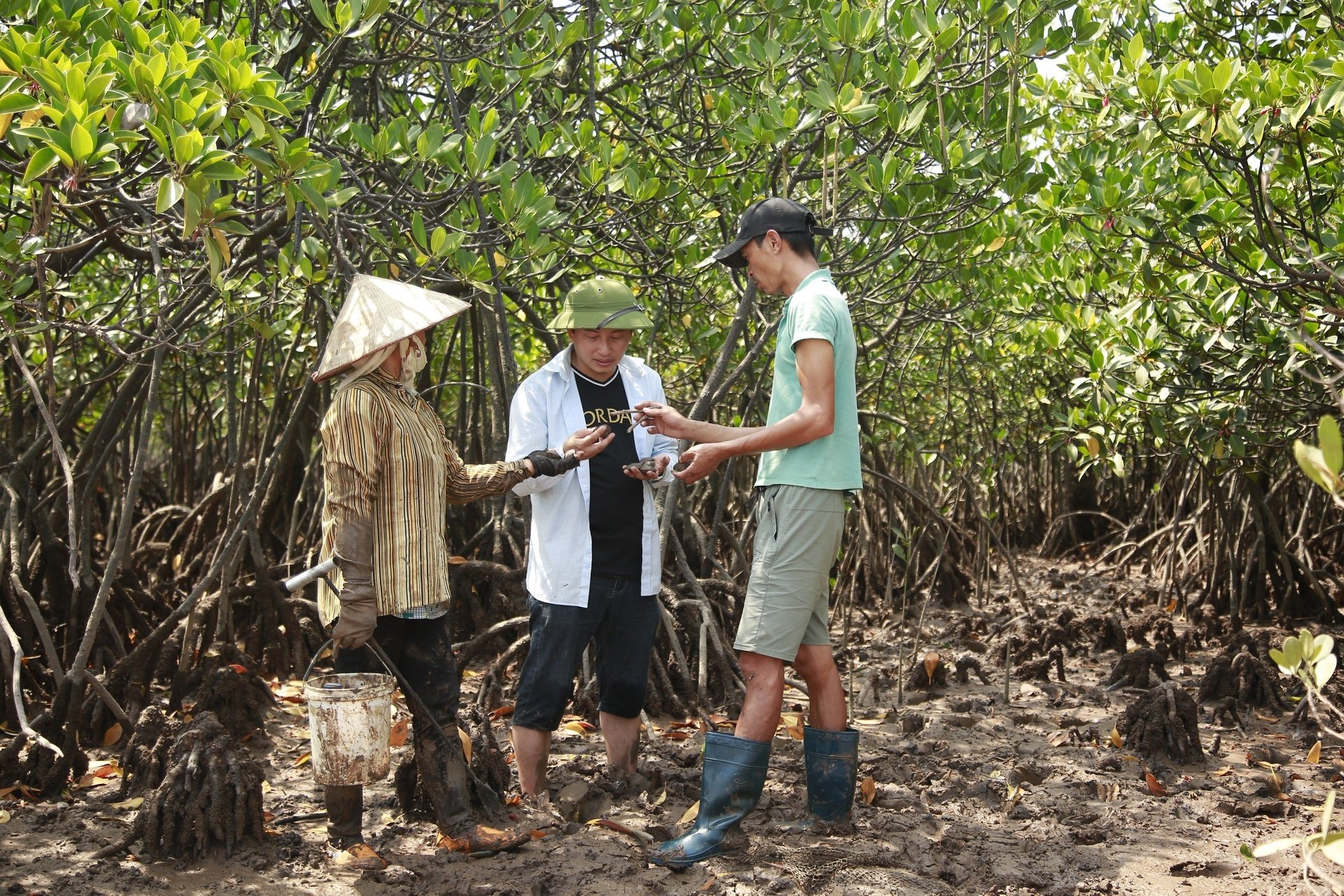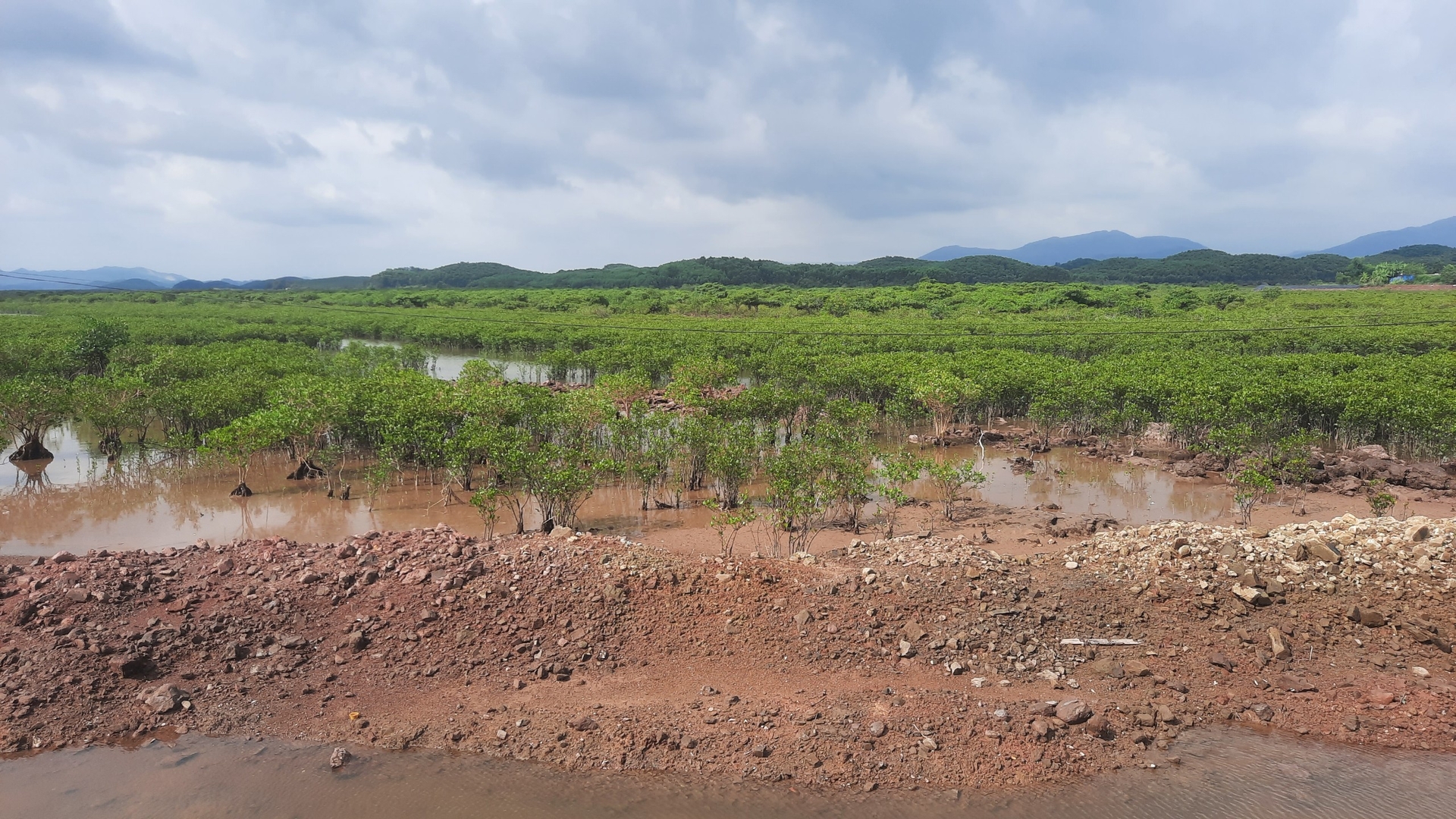May 16, 2025 | 10:42 GMT +7
May 16, 2025 | 10:42 GMT +7
Hotline: 0913.378.918
May 16, 2025 | 10:42 GMT +7
Hotline: 0913.378.918

People in Dong Rui commune (Tien Yen district) often harvest aquatic species and seafood in mangrove forests. Photo: Nguyen Thanh.
Mangrove forest around Dong Rui island commune (Tien Yen district, Quang Ninh province) is considered one of the most beautiful mangrove forests in Northern Vietnam, with over 2,000 hectares of mangroves. Significantly, mangroves have been a life source for many generations of farmers, providing rich seafood resources for the people of Dong Rui commune.
In the morning, the water touches the trunks of the river mangrove trees. The tide recedes within a few hours, revealing the rich marshes under the forest canopy. Farmers diligently dig clams from long lines on the mud at the bottom of the dike.
While harvesting clams, Mrs. Nguyen Thi Tuyet (Ha village, Dong Rui commune, Tien Yen district) shares her story. She says that besides growing rice, she and the villagers harvest clams in their idle days. Tools for harvesting are simple: a small hoe and an old paint bucket to store clams. Since clams cost 10,000 VND per kilo, she digs about 10kg daily and earns an extra income. She quickly digs, fills the bucket, and brings it to sell at the market.
Ms. Vu Thi En (village 4, Dong Rui commune) shares that after many years of planting and protecting mangrove forests in the area. The ecosystem is now abundant with mangrove trees and seafood such as clams, fiddler crabs, and mangrove worms. On average, harvesting food daily increases people’s income by about 150,000 VND per person. Villagers, from the elderly to students, participate in the activity. The mangrove canopy has created people’s livelihoods, helping many households have a stable life and exit poverty. It can be said that Dong Rui mangroves bring the “gifts of the sea” to the people here.
From the practical lessons about the negative impacts when mangrove forests are destroyed, the government and people of Quang Ninh province have actively joined hands to protect, conserve and nurture mangrove forests. Since then, the forests have become greener, beneficial for the living environment and ecosystems, and responding to climate change. Furthermore, they provide rich seafood resources, sustaining people’s livelihoods.
Mr. Kieu Van Nguyet, Chairman of the Dong Rui Commune Farmers’ Association, states that local authorities have coordinated with communal forces. Together, they inform people not to invade mangrove forests and set up forest protection groups in the villages. These actions help preserve the environment and sustainably harvest the resource. At the same time, the commune cooperates with related units and people to intercrop tens of hectares of mangrove trees, which maintains a stable mangrove ecosystem.
Ms. Tran Thi Hanh, Vice Chairwoman of Dong Rui Commune People’s Committee, says there are many ways to protect mangroves besides traditional measures such as active advocacy to raise people’s awareness. At the same time, the leaders discipline those who intentionally violate deforestation, such as building aquaculture ponds, cutting firewood, cutting bark, or exploiting seafood.
They also do not develop industrial parks and factories in mangrove areas. Ms. Hanh also looks forward to finishing plans in the region, such as ecotourism in Dong Rui, which has been stalled for many years.

Mangrove forests in Quang Ninh have been preserved and planted for many years. Photo: Nguyen Thanh.
Dong Rui commune’s natural mangrove areas have been restored, managed, protected, and developed mangrove areas. Therefore, the environment has been improved, and aquatic resources that were previously destroyed have been revived. This process helps increase people’s livelihoods, incomes, and living standards. It is known that the area of the coastal protection forest of Dong Rui commune has increased to nearly 2,200ha. This is also a “green belt,” an important shield to protect the sea dyke system as well as the lives and properties of the Dong Rui people
According to data provided by the Quang Ninh Provincial People’s Committee, the whole province currently has a total of 19,300 hectares of mangrove forests, of which 15,274 hectares are protected mangroves, nearly 4,000 hectares of production mangroves and 26 hectares of special-use mangroves.
In recent years, Quang Ninh province has organized activities to plant new mangrove forests, creating a protective coastal forest belt for stable agricultural production and aquaculture. This also improves the production quality of the local farmers. As a result, the annual cost of overcoming the consequences of natural disasters and the cost of repairing dykes in the area is reduced. Besides, it also helps to improve the ecology, reduce environmental pollution, especially coastal water pollution, preserve and expand the living environment for marine species, and conserve the coastal biodiversity of Quang Ninh waters.
Translated by: Quynh Chi

(VAN) Cold-barn systems efficiently manage environmental and temperature conditions, which aids in the prevention of respiratory diseases in pigs and protects them from the vectors that transmit African swine fevers.

(VAN) To tackle challenges, the project 'Addressing key technical bottlenecks in the grouper supply chain in Vietnam' has been underway since 2024.

(VAN) The project 'Disease-Resilient and Sustainable Cassava Production Systems in the Mekong Region', funded by the Australian Center for International Agricultural Research (ACIAR), is being implemented from 2024 to 2028.

(VAN) Data from 10,000 farming households will help professionalize production organization and support the implementation of the One Million Hectares Program for High-Quality, Low-Emission Rice Cultivation.

(VAN) FAO Director-General QU Dongyu marks International Day of Plant Health at NENA conference.

(VAN) Deputy Minister of Agriculture and Environment Hoang Trung affirmed that floriculture and ornamental plants are a growing industry that receives significant global attention.

(VAN) The three staple crops dominating modern diets – corn, rice and wheat – are familiar to Americans. However, fourth place is held by a dark horse: cassava.